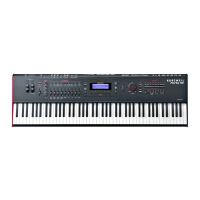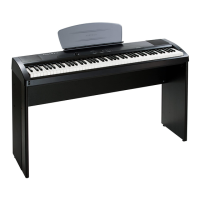Multi Edit Mode
ARP1 and ARP2 (Arpeggiator 1 & 2) Pages
11-30
AUXFX 1, AUXFX 2
Parameter Range Of Values Default Value
Override Yes, No No
Chain See Effects Chains, Appendix F 0 None
Send Levels [p], 0-100% [p]
Pre/Post [p], pst, pre [p]
e AUXFX1 (Auxiliary Eects 1) & AUXFX2 (Auxiliary Eects 2) pages determine the
behavior of the current Multi’s Auxiliary Eects. Each Multi can use up to two Aux Eects
Chains, and the program in each MIDI channel can send its audio to be processed by one
or both of the Chains. Send level and pre/post insert eects settings can be adjusted for the
program in each MIDI channel. By default, the Aux 1 and Aux 2 Chains are determined by
the program in the Aux FX Channel (set on the Multi Common page with the AuxFXChan
parameter). If you don’t want to use the Aux Chains from the program in the Aux FX
Channel, you can use the Override parameter to select a dierent Chain for one or both Aux
eects.
AUX1 Override, AUX2 Override
Normally, the Aux Eects Chains are specied by the program on the specied Aux Eects
channel. When Override is set to Yes, the Chain parameter appears, allowing you to choose a
dierent Aux eect Chain.
Set Override to Yes to select an override Aux Chain on this page. Set Override to No to use
the Aux FX chain of the specied Aux FX Channel.
Chain
When AUX1 Override or AUX2 Override is set to Yes, the Chain parameter appears. e
Chain parameter allows you to select an override Aux Chain for the corresponding Aux
Eect (or set the Chain to 0 None to disable the Aux Chain). e Aux Override Chain is
used instead of the chain of the specied Aux FX Channel. (See Appendix F for a full list
of available Eect Chains.) Press the Edit button to edit the selected Chain.

